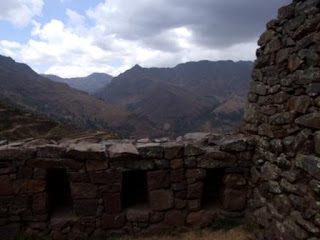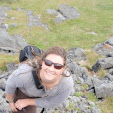I found myself at the same hostel as before, Southern Comfort, "circa de Puente Grau", as before and acquired a bed shortly after to pass out for just a while longer before I got my groggy bottom out of bed and onto a tour bus to visit the three famous city-ruins of the Sacred Vallley: Pisac, Ollantaytambo and Chinchero. It was non-stop action. Here's this, here's that, ok, back in the bus. Monica!!! We're going to leave you!
Instead of bore you with some facts I scribbled while translating the tour guide's speech into English, I'll just post some nifty pictures and refer you to Wikipedia for facts about these magnificent places: http://en.wikipedia.org/wiki/Sacred_Valley
 The modern city of Pisac's market day-I bought gifts for the family. These are your Christmas presents guys. FYI
The modern city of Pisac's market day-I bought gifts for the family. These are your Christmas presents guys. FYI
The Inca kept cuyes(guinea pigs) which would sleep under the bed. Give a whole new meaning to dust bunnies.
 Crafted stones for a door.
Crafted stones for a door. Room with a view. The Inca were into cubby holes.
Room with a view. The Inca were into cubby holes.On to Ollantaytambo!

 Carved stone.
Carved stone.Time is up. Let's go. We need to make it to Chinchero. Monica!! Get on the bus.
Then we were invited to see a demonstration of how the locals dye the wool they use to create lovely alpaca goods: gloves, scarves, blackets, caps, ect.
 Dying properties.
Dying properties.
 The demonstration.
The demonstration.
 Weaving and the significance of collars used. Each item they create tells a story about their way of life.
Weaving and the significance of collars used. Each item they create tells a story about their way of life.
 Sacred cross in plaza.
Sacred cross in plaza.
 Church on the ruins of Chinchero.
Church on the ruins of Chinchero.
 Better view.
Better view.
 Last remaining ruins of Chinchero. Not much is known about this location.
Last remaining ruins of Chinchero. Not much is known about this location.
Then we were invited to see a demonstration of how the locals dye the wool they use to create lovely alpaca goods: gloves, scarves, blackets, caps, ect.
 Dying properties.
Dying properties. The demonstration.
The demonstration. Weaving and the significance of collars used. Each item they create tells a story about their way of life.
Weaving and the significance of collars used. Each item they create tells a story about their way of life. Sacred cross in plaza.
Sacred cross in plaza. Church on the ruins of Chinchero.
Church on the ruins of Chinchero. Better view.
Better view. Last remaining ruins of Chinchero. Not much is known about this location.
Last remaining ruins of Chinchero. Not much is known about this location.I returned to the bus with the sun light fading and a lightning storm on the horizon. It was a lovely ending to a fascinating and rather exhausting day.








































